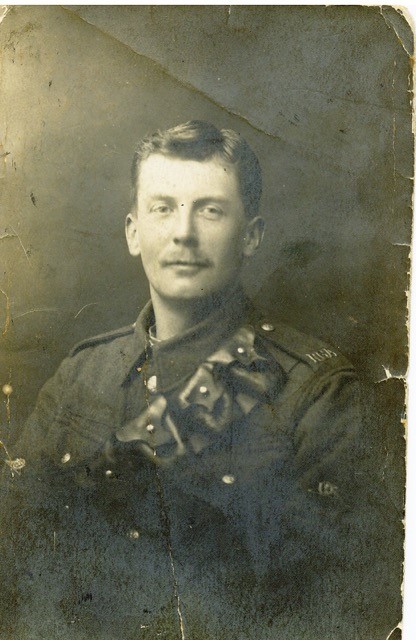
Submitted by Ron Taylor, “raised in Shute Road Catterick Camp, moved to Scotton and was schooled in Richmond before wandering around with the forces”……who wanted to tell us about his grandfather, Percy.
Percy was born about 1891 in Brighton Sussex, and died 20 September 1967 aged 76.
68703 Bdr Percy Levi Lelliott, enlisted in the 119th Siege Battery, Royal Garrison Artillery, Sussex on 12 Dec 1915. He undertook initial training at Shorncliffe. His unit embarked for France on 5 June 1916, and he fought at the Battle of the Somme. Percy distinguished himself in the field on several occasions by bringing in wounded men under heavy gunfire, sometimes dragging them by his teeth. He was subsequently awarded the DCM. Discharged as Sgt (Acting BSM) 13 February 1919.
Percy retired in 1946 after a long career in the Police Force. PC Lelliott received four Commendations from the Watch Committee and local magistrates, two of which referred to rescue operations at Fairlight and Ecclesbourne Cliffs. Retired, Grandpa Percy sat in his Windsor Chair, smoked his pipe and tended his greenhouse.

Percy Lelliott’s Distinguished Conduct Medal citation

His medal card
Explore more memories from the ribbon
-
George Ellis
Submitted by Pauline Blewis. George was born in Old Malton and joined the Green Howards in around 1905. In the same year he married Annie Hemstock, a Richmond girl. Their family of three sons and a daughter were raised in the barracks, now the Garden Village. George served during the Boer War and during the First World War was transferred to the 13th Battalion (October 1915)- the battalion was made up of ‘Bantams’. George served through the war up to the Battle of Cambrai. On 23rd November 1917 he was sent up to the front line with his battalion with the aim of taking Bourlon Wood and village. Tanks were sent in with the infantry following up, eventually the village was taken after hand to hand fighting. George died during this advance and while his body was never found his name is inscribed on Panel 5 of the Cambrai Memorial. After his death the family were moved from the barracks into a house inside Richmond Castle.
-
Thomas Ginger
Lieutenant Thomas Ginger. Signals Officer. 4th Battalion. Thomas Ginger was awarded the Military Cross as a result of his bravery during the German ‘Spring Offensive’ of March 1918. In the citation for his award it describes how ‘On the first day his senior Officers were killed and in numerous rear-guard actions he found himself in command of considerable bodies of men’. One such example is during the retreat across the River Somme near Brie, when Ginger was ordered to take his men and cover the retreat of the remains of the 50th Division. He took his tired men to the far bank and took up positions to hold the advancing Germans back. At the same Lt George Begg, 239/Field Company was wiring the bridge that the retreating men were crossing. As German troops started to appear on the horizon and the last of the Durham Light Infantry crossed the bridge, Begg primed the detonator and pressed the plunger home. Nothing happened. This was repreated three times. When the bridge did blow, Begg looked across the river to see Ginger and his men still focusing fire on their foe. Eventually Ginger managed to construct a rudimentary footbridge, allowing his men to cross to safety.
-
Arthur Bateman
The story of Private Arthur Bateman was compiled by Margeret Sparke, his granddaughter. Arthur was born in 1879 – the son of William and Mary Bateman of Battersea. He worked as a labourer and married Emily Jackman in September of 1903. After the outbreak of war Arthur joined the Yorkshire Regiment, enlisting at Kingston-on-Thames. His service was quite unusually as he was posted to a total of 4 battalions. He served with the 4th, 7th, 6th and 2nd battalions of the Yorkshire Regiment. He has two regimental numbers (9166/235033) – the earlier number suggests that he may have served with the 4th battalion before the war as a Territorial soldier. He died on 6th November 1918, just before the Armistice came into force and is buried in Bettrechies Communal Cemetery in France. Tragically, with Arthur’s death being so close to the end of the war, his widow Emily only found out that he had been killed in action while taking part in an Armistice street party.
